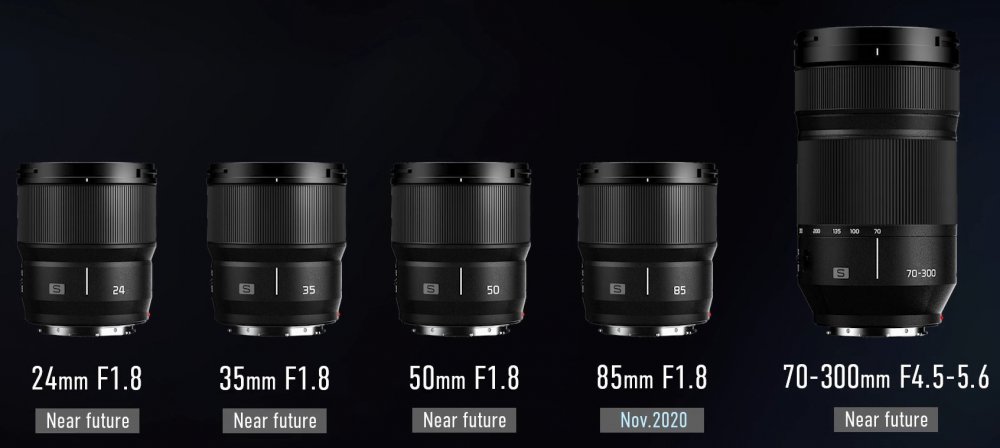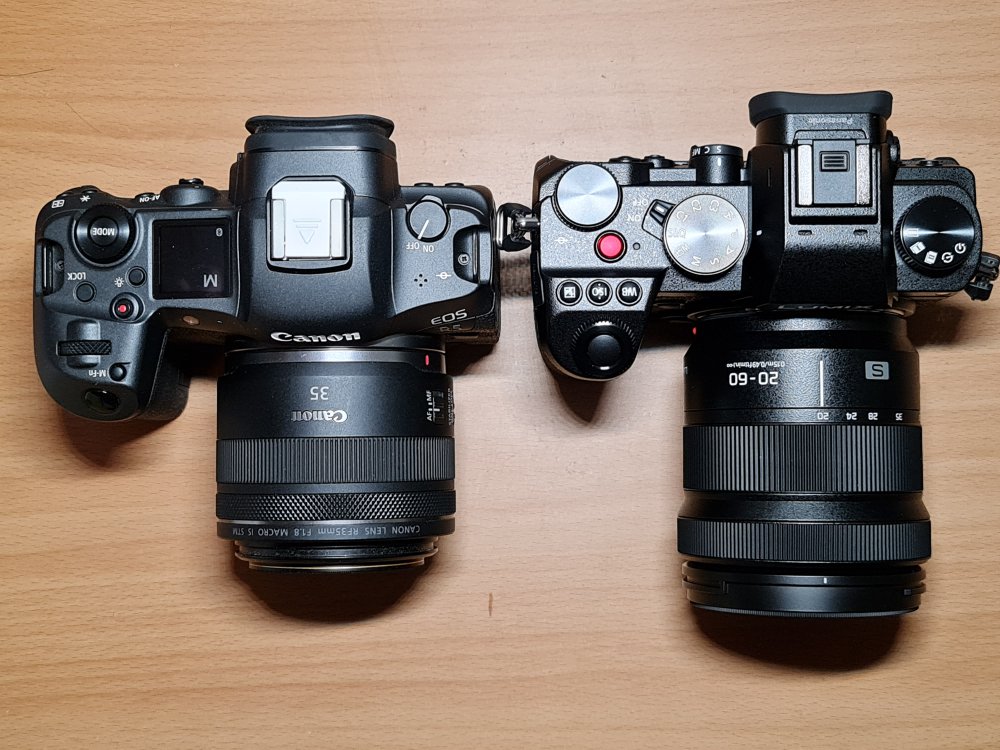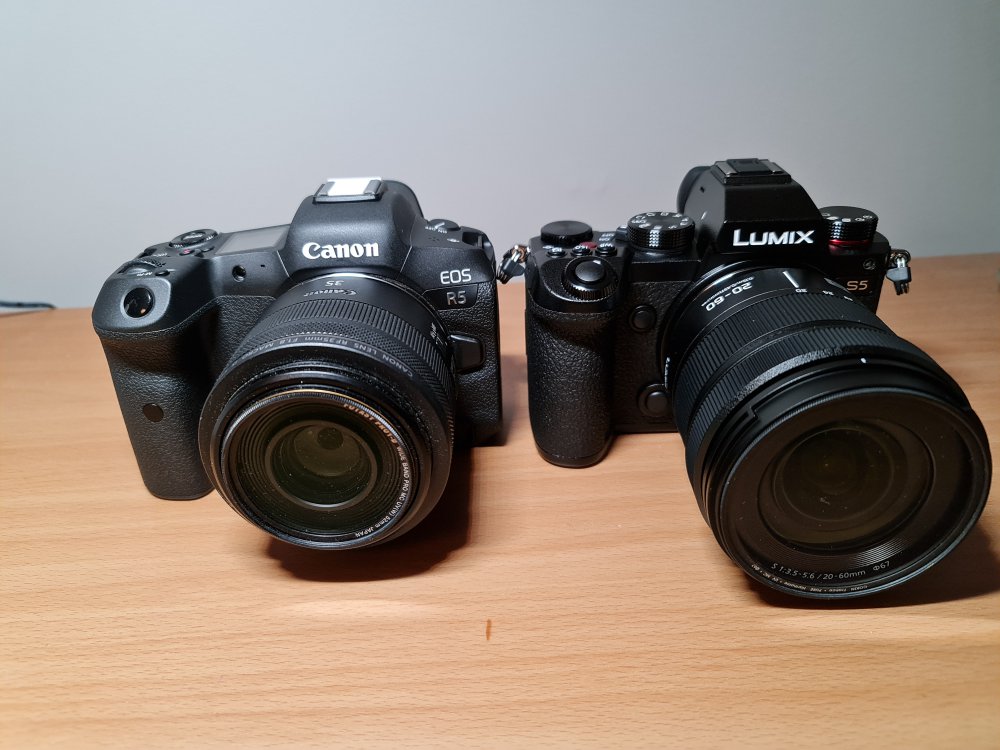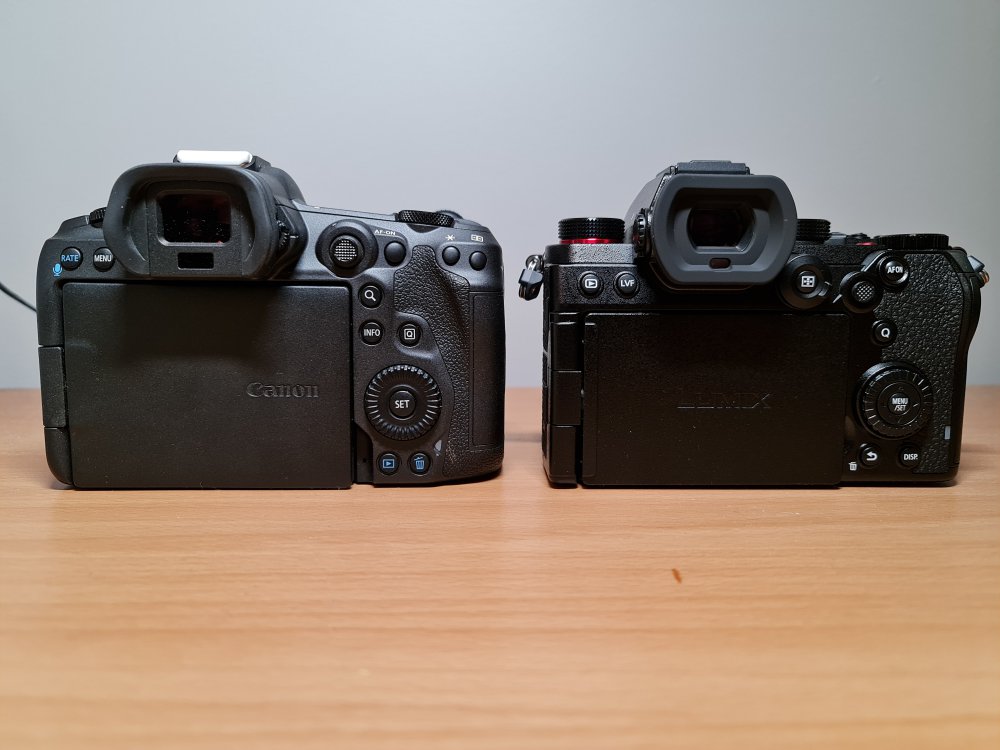
currensheldon
-
Posts
436 -
Joined
-
Last visited
Content Type
Profiles
Forums
Articles
Posts posted by currensheldon
-
-
With all that being said, a speedbooster takes care of the issue on the C70, because now you can use EF full-frame lenses, either the 24-105mm lenses that have great IS and still get you f2.8 or snag a 24-70mm and have an f2. Pretty great.
-
3 hours ago, jpleong said:
Can you help me understand your experience a bit when you say "awkward focal lengths on Super35"? Like, under what conditions are you shooting?
The filmmakers I studied under using Super 35, its equivalent sensor size, or a 4/3rds sensor always used focal lengths that were readily compatible with common "full frame" lenses. For doc interviews, I was taught 50mm/35mm (Super 35 and 4/3rds, respectively) for A Cam, 35mm/24mm for B Cam with wider-than ~50º field of view kind-of a niche thing because of perspective distortion. Because of that experience, I've always been happy shooting APS-C with 16-35mm, 24-70mm, and 70-200/300mm L zooms in my bag (I also have a 10-18mm STM but I never use it for doc work).
Sure - I guess I'm mainly talking about observational, verite documentary filmmaking (or any run-n-gun situation), where you don't know where you are going, what the light conditions will be, and what type of space you'll be in. And you may not have time to switch lenses. And it is up to you to cover a short scene so that an editor can make a decent 2-3 minute scene out of what you capture (wides, closeups, multiple angles, etc).
So, for those scenarios, 24mm on the wide end is close to a must and at least 70mm on the long end. So, on a full-frame camera (or at least on a full frame field of view) a 24-70mm f2.8 is nearly perfect. But on Super35, you would need something like a 16-55mm f2.8, which Canon doesn't make and the 17-55mm they do make doesn't even cover most of their modern Super35mm sensors (C200, C300) and is also a cheap, plastic-y lens. Their 18-80mm T4.4 is great, but pretty slow aperture for a lens that expensive and on a non full-frame camera.
Add in that mots 24-70mm lenses do not have stabilization (which is also imperative for the situations I detailed above), and you have very limited choices.
I don't know why each manufacturer (Canon and Sony, mostly, but also Panasonic (Varicam LT and EVA-1) doesn't have a professional 16-55mm f2.8 lens with IS to go with their Super35mm video camera - seems like it should have been released alongside any of the C-series or FS5/7 series.
-
For me, Canon's RF Mount has been a bit frustrating because using EF lenses actually gets you some really useful features on RF cameras. For the EOS R, R5, or R6, it's being able to use the amazing variable ND filter adapter, making swapping lenses so much easier. And now, for he C70, you can get full-frame FoV and an extra stop of light by using a speedbooster. The RF lenses are amazing, but since they are full-frame, give you some awkward focal lengths on Super35. The 24-70mm would be amazing with the C70 since it has IS, but a 35mm FoV on the wide end isn't wide enough. And the 15-35mm just won't have enough reach.
If I do end up getting the C70, then I think for doc-work, I would definitely snag the speedbooster and a 24-105mm f4, which would have the same FoV as on a full-frame and give me a f2.8 from 24-105mm. This is what I did with the Sony FS5 when I had it, and it's nearly perfect for doc-work. Either that for a 24-70mm (Canon or Sigma with IS) and have a 24-70mm f2 - pretty great lensing options there.
-
2 hours ago, Amazeballs said:
The DR is quite good on all Panasonic S cameras as I've seen. I have 3 major problems with the system:
- absence of cheap compact lenses
- AF
- no FF 4k60
The first one should be solved very soon:
Sigma and Panasonic are both great at making their more affordable lenses still very high-quality, unlike Canon and Sony who make their f1.8s with more plastic and cheap-feeling materials - so these lenses should be excellent.
Wonder if they could add FF 4k60 to S1H with a firmware (and 120fps in 4k)?
--
The S5 looks awesome and it's a hard decision between keeping the S1H and adding an S5 for B-Cam/Photo cam or go with the Canon C70. I want to stick with Panasonic, but Canon is pumping out cameras and lenses at an insane rate.
-
14 hours ago, ntblowz said:
I thought the same thing about the EOS R. Why do Canon's expensive mirrorless cameras feel like toys? Sony's A7 series does too, as well. But man, the Panasonic cameras are built SO NICE. Love their design, the way they look, feel, operate, and how they feel like professional tools.
- Lux Shots, ntblowz and Trankilstef
-
 3
3
-
10 hours ago, IronFilm said:
Of course! Hire professionals.
But yes, even if you're doing it OMB and handling audio yourself, a camera like a Sony FS7 *is* easier to use for audio than a Canon EOS M50.
Now I'm not saying you couldn't get just as "acceptable" audio on a M50 as a FS7 in ideal conditions, but I am saying the FS7 makes your life easier. (which means less mistakes and screw ups)
This difference might only be small, it might only make your life 5% easier (although the likes of NDs, SDI, waveforms, and more, makes your life easier by far more than just 5%!), but if you've got thousands of dollars of client's money riding on this shoot and you not screwing up the audio, then that 5% difference starts to really matter a lot to you! And suddenly the difference between renting an M50 or a FS7 now feels like nothing at all.It's so true. People freak out about this spec or that spec, but as a whole package, the C70 is WAY more usable than any mirrorless could ever be (as any dedicated video camera would be).
If I wanted to use the R5 (or any mirrorless) vs the C70, the main differences would be:
- ND Filters - I would need to carry multiple NDs or have high-end variable NDs (not allowing me to use a lens hood, which I greatly prefer) or get a mattebox. You break your ND filter (AND your backup) and your video shoot is done. Just like that.
- Audio - I would need to have a MixPre-3 or some other recorder.
- Monitor - People say the C70 monitor is as good as C500/300, so that's good enough for me. Most mirrorless cameras are not that good, so usually add a monitor for pro work.
- Batteries - Would need a lot more batteries, therefore a lot more chargers and more weight in the long run. Plus extra batteries for the audio recorder and monitor, both of which are pretty power hungry.
- Timecode - Other than the S1H (which I love), there is no way to sync timecode in mirrorless cameras unless you have a Tentacle Sync, which is great, but is a few more things to charge, keep an eye on, and your audio is now one long very loud static track.Suddenly, using something like the C70 is looking about 50-60% easier and smoother. And there is only one failure point: the C70. With the other setup, there are multiple fail points that may not sink the shoot, but make your life extremely difficult.
I've used mirrorless cameras on productions for one reason: SIZE. Great for gimbals and being discrete. The C70 changes that - and is the first real video camera to do so. That's a HUGE bonus in my book.
- Kisaha and Video Hummus
-
 2
2
-
I love Panasonic and honestly, this is what the S1H should have been.
To me, this is nearly the perfect do-almost-everything camera. Been what I have been wanting and asking for for 5 years (ever since I wanted to upgrade from the C100 II).
The fact that this can do 120fps with the full-frame FoV with speedbooster and all in 10-bit 422 is amazing. Would be competing with my S1H, but with Canon lenses, Canon AF, internal NDs, two XLRs on body, full-frame FoV in all modes, and that C300 III sensor (which is amazing, even though the S1H is also amazing IQ), The S1H really only has IBIS on this.
-
Yea just saw this as well. Pretty tempting over something like the S1H, which I have and love, because of the AF, internal NDs, and 120fps in 4k. And that C300 III sensor is sweet (though, so is the S1Hs). But, knowing Canon, this thing won't have timecode, which has been huge for me with the S1H and hard to not have once you've had it. Plus having full-frame and IBIS is excellent.
Hoping Panasonic updates the S1H with 120fps in 4k. Seems like they have to to compete in the new R5, A7sIII, and C70 market - unless they're aiming to put out a S2H soon (which would be sort of crazy soon) or an EVA-2 which will be closer to the C70 in size, price, and market.
-
I've had to sell a couple clients on the S1H but both have been amazed with the quality next to a C300 II and an FS7 II, both of which I think the S1H image trumps. They didn't ask for anything else the next few times I went with the S1H. Add in that a 24-70mm f2.8 can cover almost every situation on a full-frame and the stabilization is amazing, I can just get better shots and images with the S1H.
I wonder if they could give us a firmware update to add-in 120fps in 4k. That would put it back in the specs league with the R5 and A7sIII - as it is way more usable and better camera than those two.
-
Yes - updated monitor! Eva-1 monitor was unusable.
-
Basically an S1H with 120fps in 4k in a video-camera body (XLRs, internal NDs, etc). Has to be 20-24 megapixels to get 6k raw output or maybe even get it up to 8k raw output (36 megapixels?).
- maxmizer, Zak Forsman and IronFilm
-
 3
3
-
In my opinion, Panasonic makes the best cameras with the best IQ (especially video IQ) in the business. They are reliable, packed full of features, ergonomically nearly perfect, and just fantastic to use. The S1 and S1H (and seemingly the S5) are the most useful mirrorless tools and the S1H in particular is a brilliant video camera.
But Panasonic needs to go all-out with L-Mount NOW, because Canon and Sony are going gangbusters with camera releases. With the C70 RF and Sony FX6 coming out soon, Panasonic needs to release an EVA-2 ASAP and load it with features to solidify the L-Mount. The EVA-2 has to be an FS7-type release, where they give out features that no other manufacturer has at that price point. Main competition will obviously be the C300 III, FX9, FX6, and C70.
Here is what I think they need to do:
- Release EVA-2 with L-Mount
- FULL FRAME - has to be.
- 120-180fps in 4k (C300 III and C70 does this, but has a Super35 sensor)
- IBIS - first ever in a cinema camera and make it LOCKABLE (I know cinema cameras "NEVER!" have IBIS, but I think the market would love it).
- Dual ISO (640 and 4000)
- 12-bit codec - Codecs in EVA-2 and S1H and 5.9k ProRes Raw output are great - internal raw would be excellent but maybe not possible. An internal 12-bit codec would be awesome though.
- PDAF - I don't care as much about AF, but the market demands it. At least the S5 AF in the EVA-2.
- Compact Body - Make it smaller, more like the FS5 sized than EVA-1
- $7499 - Same price as EVA-1 and WAY below any full-frame cinema camera with these specs. Could even go closer to the FX9 ($10k even) with these specs.If they put out a pretty standard Super35 camera with 4k 60fps and raw out (basically an EVA-1 with L-Mount), they're not going to gain much traction. They need a GH5-level release (2-3 years ahead of the competition on specs) but in full-frame. The FS7 changed the trajectory for Sony and wasn't matched on specs and price until the EVA-1, nearly 3-4 years later. They need THAT type of camera now.
- Amazeballs, Geoff CB and IronFilm
-
 3
3
-
19 hours ago, Trankilstef said:
Pretty excited by this camera as it is the one I was waiting for in the L-mount system : a smaller camera than my S1H that could still shoot awesome video to match with the bigger brother, being quite smaller to be my B-cam/gimbal cam, also my main stills camera, and one that I could bring everyday to shoot some street and mundane photography (without the hassle to release the S1H from the rig/cage between pro gigs) and one camera that I could take on vacation without sacrificing any quality in stills picture and video.
Exactly my thoughts as well. I prefer using Panasonic or Canon and Canon really blew it with the R5 and R6 for video shooters (I also just don't like the ergonomics and design of their RF mirrorless cameras). The C70 looks really interesting, but not sure it will be any better than the S1H, which is my favorite sub $15k camera/image I've ever used.
But I have been reluctant to go full L-Mount due to the lack of a smaller camera I can use as a B-Cam and as my photography camera. But with the S5 and a small 24mm and 50mm coming out soon (hopefully by end of year?), I'm pretty stoked to have the S1H/S5 combo for the next few years at least.
Now an L-Mount, full-frame EVA-2 needs to come very soon.
-
Oof, hate to admit it but this is close to the camera I've been wanting for 4-5 years. A small, compact cinema camera with all the bells and whistles (ND, xlr, etc). I think Panasonic would have been smart to do this with the S1H - make it a bit bigger, add NDs, mini XLRs, and charge an extra $500-1000. That would have quieted some of the AF chatter too.
Canon is frustrating, especially right now, but this does look pretty amazing.
-
Looks awesome. Love that size comparison.
I think Panasonic's design and button layout are both nearly perfect. Love the WB, ISO, and +/- buttons. Love that front Fn button for LUT assist or lockdown IBIS mode (having two on the S1H is even better). I also really like those top mode dials and having C1, C2, C3 ready to roll - I program these as soon as I get a camera and it's a pain when some cameras make them difficult to access (EOS R...)
Looking forward to this.
-
Panasonic GH6
In: Cameras
On 8/26/2020 at 7:03 PM, Mmmbeats said:I think currensheldon meant that 6400 or below covers 98% of use cases, rather than that most were actually shot at 6400.
Correct. Shooting BELOW 6400 ISO is 98% of use cases. But I usually shoot (75% of the time) at whatever the native ISO is (640 ISO for GH5, if I remember correctly?).
Even with the S1H, I almost never go above 4000 ISO.
-
Panasonic GH6
In: Cameras
For MFT and GH6 to survive now that everyone has caught up with the GH-series but in full-frame (10-bit, All-I, 60fps in 4k, etc) is to offer things that will take another 3-4 years for other manufacturers to do (especially since Canon and Sony have just put out their mirrorless video flagships):
- high frame rates (for sure), including 120-180fps in 4k at good bit rates (and not insane ones like R5). Maybe even 480fps in HD?
- e-ND - they HAVE to have internal ND filters.
- GH5s or better low light - just to at least be in the same ballpark as Super35/full-frame (meaning usable to 6400 ISO, which is 98% of use cases)
- Internal raw or at least some form of 12-bit compression that gets you close to raw quality (BM Raw?)
- Great XLR capabilities - perhaps a better version of the grip that is also dual XLRs? I would prefer this than the hotshoe one so there is still a place to mount a microphone without a cage (or to keep your monitor centered over camera).
- Global Shutter or miniscule rolling shutter - MFT has always been good for this, but now to take it a step further.
- $1799 or lower - Has to be cheaper than entry-level full-frame and something like the XT3.
- Tof AF? - I don't care a ton about AF (always seems to fail me in critical moments with Canon/Sony so I don't use it), but so many people care A LOT, that they have to do something.
- Insanely good IBIS - This has always been Panasonic's strong suit, but Canon has caught up. So 8-10 stops of IBIS and improved mechanism for walking forward to create close-to-gimbal like movement.Pair this camera with the 10-25mm f1.7 and video shooters are set.
-
From @AndrewReid - "more than you expect" - very intrigued. I'm guessing everyone here as seen the leaked specs, so I wonder what the "more" is? Perhaps the AF actually works? ToF or some new DFD algorithm make it feel and act like PDAF? Possible?
-
Outside of a downgraded EVF, monitor, battery, and a few other things, this is basically a small S1. All of those things may matter to some users, but I definitely prefer the smaller body - especially for photo projects.
Since the S1 is selling for $2k (with a free V-log upgrade) here in the USA, I wonder what this will be. $1699? Would be very competitive at that price.
-
The S1's AF with Panasonic, native lenses (or the Sigma 45mm f2.8, which I have also tried) seemed pretty darn good to me. If the subject is clear and there was decent contrast, it seemed pretty darn smooth to me. Where it had trouble is backlit subjects or scenes with very little contrast. But, at the same time, the EOS R and C200 have failed on me consistently under the same conditions and I've missed shots relying on the AF.
-
Geez. Craziness. I wonder if they'll now release a firmware that "fixes" the problem and lets you at least record to the limits they stated. Still wouldn't be as usable, but they'd get a ton of Youtubers/influencers making update videos: "Canon fixes overheating and now the R5 is an unstoppable BEAST!" and "Why I switched to Sony from Canon and now from Sony back to Canon: overheating crushed!! R5 UNSTOPPABLE?!"
It's like a double-launch.
-
With the V-Log upgrade, the S1 matches the S5 in specs on almost everything (except 10-bit 60fps 4k and some anamorphic modes, perhaps?). But on the S1 you also get: a more robust build, much better EVF, longer battery life, better back monitor, and a top LCD (for those who like that).
While in specs they are (close) to equals, the S5 will definitely be cheaper because those changes are how manufacturers really save money on manufacturing costs. As an S1H owner, I can live with those changes because I'm way more interested in having a smaller, lighter L-Mount camera for photos and a gimbal b-cam when needed. So, very pumped for the S5 and ready to fork over $2k for it, but thinking it will be closer to $1699 - $1799... hopefully.
-
28 minutes ago, herein2020 said:
But back to the topic of the S5...it is DOA for me, if this camera is why there is no GH6 then I will be sorely disappointed. I have all the MFT glass I want and my GH5 already has no recording time limits, never overheats, does dual card slot recording, etc. I have a feeling the S5 will have a recording time limit like the S1, may not work with the XLR audio module, and will require me to invest in L mount lenses. It also does not do 4K120FPS, and I still would prefer my Canon 5DIV for photography.
It's definitely a full-frame L-Mount camera, so if you want an MFT camera, the S5 won't be it. Though, I still think a GH6 is coming.
The S5 is compatible with the XLR-module, has dual SD card slots, and it doesn't appear to have recording limits (some are listed, but seem to mean battery life, as the "limit" is 110 minutes).
-
47 minutes ago, no_connection said:
"3.98p, 72Mbps (4:2:0 10-bit LongGOP) (H.265/HEVC, AAC)"
Is that really official spec? Maybe it leaked going out for spell check, but even then it's a bit too glaring of a typo.
I think it's just missing a "2" - so 23.98, 72mbps
I actually loved this Codec on the S1, though I don't believe it made it to the S1H. Having a 10-bit codec with such small file sizes was pretty great and if you hit exposure right, was very high-quality for what it was.






Canon Cinema EOS C70 - Ah that explains it then!
In: Cameras
Posted
And therein lines the problem with the RF Mount right now. The RF lenses are AMAZING, many of the main zooms are all stabilized, and are just wonderfully built, designed, and more modern AF systems than the EF lenses. However, to get the most out of the RF-mount cameras for video, it makes a lot of sense to use EF glass. For th R5 and R6, so you can use the variable ND adapter (rather than having a variety of variable NDs for the front of you lenses and dealing with the issues that brings (like not being able to use a lens hood, difficult in wet weather, etc), and for the C70, you can use a speedbooster to get a full-frame field of view and extra stop of light and shallower depth of field when needed/wanted.
I'd love to have a system that allows me to use all the beautiful mirrorless lenses, especially in RF and L-Mount, but those are pretty much just for full-frame or don't have dedicated cinema cameras that use them (L-Mount). Tough decisions, but perhaps EF glass for another 3-years and shooting with the C70 isn't too bad. haha